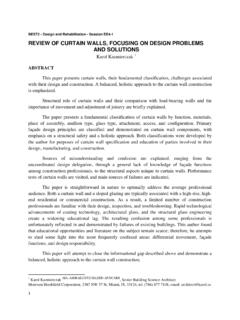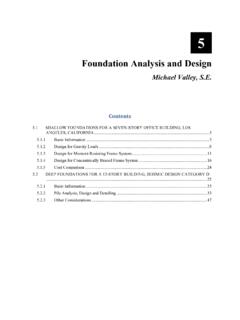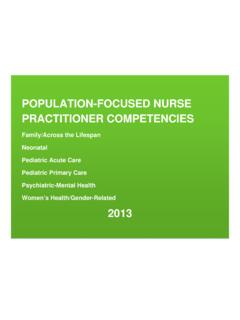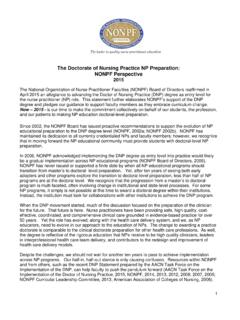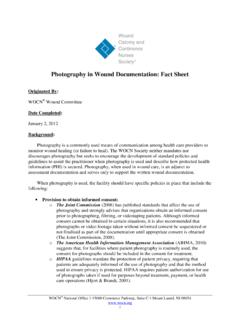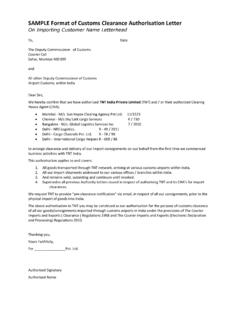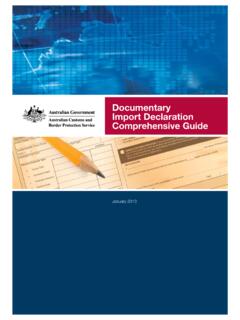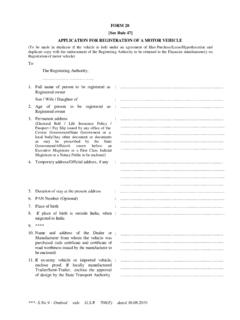Transcription of AMOXICILLIN AND CLAVULANATE (Veterinary—Systemic)
1 2007 The United States Pharmacopeial Convention All rights reserved 1 AMOXICILLIN AND CLAVULANATE (Veterinary Systemic) A commonly used brand name for a veterinary-labeled product is Clavamox. Note: For a listing of dosage forms and brand names by country availability, see the Dosage Forms sections(s). Category: Antibacterial (systemic). Indications Note: Text between ELUS and EL describes uses not included in product labeling. Text between ELCAN and EL describes uses not included in Canadian product labeling. The ELUS or ELCAN designation may signify a lack of product availability in the country indicated. See the Dosage Forms section of this monograph to confirm availability. General considerations AMOXICILLIN has activity against penicillin-sensitive gram-positive bacteria as well as some gram-negative bacteria. The gram-positive spectrum of activity includes alpha- and beta-hemolytic streptococci, some Staphylococci species, Clostridia species, and some Bacillus anthracis.
2 {R-2} AMOXICILLIN is also effective against gram-negative bacteria, including Escherichia coli (E. coli), many strains of Salmonella, and Pasteurella multocida.{R-2} AMOXICILLIN is sensitive to destruction by beta-lactamases and therefore when administered by itself is not effective against bacteria, such as Klebsiella and Proteus, that produce these enzymes.{R-2} CLAVULANATE is a naturally occurring noncompetitive inhibitor of beta-lactamase produced by gram-positive, and also many gram-negative, bacteria.{R-3; 4} Although it has a beta-lactam chemical structure, clavulanic acid has little antibacterial activity of its own. However, when clavulanic acid is administered concurrently with AMOXICILLIN , it extends the activity of AMOXICILLIN by preventing its destruction by bacterial enzymes. Beta-lactamase inhibitors will only assist in the destruction of bacteria that produce beta-lactamase enzymes; other forms of resistance, such as alteration of penicillin-binding protein, are not affected.
3 Also, the beta-lactam structure of AMOXICILLIN and CLAVULANATE may stimulate some bacteria to produce more beta-lactamase; it is easier for CLAVULANATE to protect AMOXICILLIN against a small amount of enzyme than against a large amount. CLAVULANATE extends the spectrum of activity of AMOXICILLIN to include beta-lactamase producing E. coli, Klebsiella, Proteus, and Staphylococcus species.{R-4; 6} Most anaerobes, including Bacterioides fragilis, are susceptible to the combination of clavulanic acid and AMOXICILLIN .{R-5} However, some beta-lactamase enzymes, including those produced by Enterobacter and Pseudomonas, are unaffected by CLAVULANATE .{R-6} Accepted Periodontal infections (treatment) Dogs: AMOXICILLIN and CLAVULANATE combination is indicated in the treatment of periodontal infections caused by susceptible strains of aerobic and anaerobic bacteria.{R-1; 7-10; 31} Skin and soft tissue infections (treatment) Cats and dogs: AMOXICILLIN and CLAVULANATE combination is indicated in the treatment of skin and soft tissue infections caused by susceptible Staphylococcus species, E.
4 Coli, Pasteurella species, and Streptococcus species.{R-7-10} Urinary tract infections, bacterial (treatment) Cats and ELUS dogs EL: AMOXICILLIN and CLAVULANATE combination is indicated in the treatment of urinary tract infections, including those caused by susceptible E. coli.{R-7-11} Potentially effective ELUS,CANO steomyelitis (treatment)EL Cats and dogs: There are insufficient data to show that AMOXICILLIN and CLAVULANATE combination is effective in the treatment of osteomyelitis in cats and dogs; however, in vitro studies show that the bacteria causing this type of infection are often susceptible.{R-32-34; 37} Chemistry Source: AMOXICILLIN Semisynthetic derivative of ampicillin.{R-12} CLAVULANATE A fermentation product of the actinomycete Streptomyces clavuligerus.{R-7; 8} Chemical name: AMOXICILLIN 4-Thia-1-azabicyclo[ ]heptane-2-carboxylic acid, 6-[[amino(4-hydroxyphenyl)acetyl]amino]- 3,3-dimethyl-7-oxo-, trihydrate[2S-[2alpha,5alpha,6beta(S*)]] -.{R-13} CLAVULANATE potassium 4-Oxa-1-azabicyclo[ ]heptane-2-carboxylic acid, 3-(2-hydroxyethylidene)-7-oxo-, monopotassium salt, [2R-(2alpha,3Z,5alpha)].
5 {R-13} Molecular formula: AMOXICILLIN C16H19N3O5S 3H2O.{R-13} CLAVULANATE potassium C8H8 KNO5.{R-13} Molecular weight: AMOXICILLIN {R-13} CLAVULANATE potassium {R-13} Description: AMOXICILLIN USP White, practically odorless, crystalline powder.{R-14} CLAVULANATE Potassium USP White to off-white powder. Is moisture-sensitive.{R-14} pKa: AMOXICILLIN and {R-16} CLAVULANATE {R-17} Solubility: AMOXICILLIN USP Slightly soluble in water and in methanol; insoluble in carbon tetrachloride, and in chloroform.{R-14} CLAVULANATE Potassium USP Freely soluble in water, but stability in aqueous solution is not good; optimum stability at a pH of to ; soluble in methanol, with decomposition.{R-14} Pharmacology/Pharmacokinetics Note: There is evidence that giving AMOXICILLIN with CLAVULANATE has little effect on the pharmacokinetics of either medication.{R-17; 24} Mechanism of action/Effect: AMOXICILLIN Bactericidal. AMOXICILLIN must reach and bind to the penicillin-binding proteins on the inner membrane of the bacterial cell wall.
6 In actively growing cells, the binding of AMOXICILLIN within the cell wall leads to interference with production of cell wall peptidoglycans and subsequent lysis of the cell in an iso-osmotic environment.{R-18-20} CLAVULANATE Binds irreversibly to susceptible beta-lactamase enzymes, preventing hydrolysis of the AMOXICILLIN beta-lactam ring. When CLAVULANATE binds with the enzyme, a chemical complex is formed, which destroys the CLAVULANATE and inactivates the beta-lactamase.{R-3; 4; 6} Absorption: Cats and dogs Both AMOXICILLIN and CLAVULANATE are stable in gastric fluid and, therefore, are well absorbed after oral administration.{R-6; 7; 21-23} Calves Preruminant calves (2 weeks old): Absorption of AMOXICILLIN when administered in combination with CLAVULANATE at doses of 10 to 20 mg per kg of body weight (mg/kg) is 34 2007 The United States Pharmacopeial Convention All rights reserved 2to 36%.
7 Early ruminant calves (6 weeks old): Absorption of AMOXICILLIN and CLAVULANATE combination is much poorer than in preruminant calves given the same dose; early ruminant calves do not develop therapeutic serum AMOXICILLIN concentrations.{R-26} Horses Orally administered AMOXICILLIN is only 10% absorbed in adult horses.{R-36} Peak serum concentration: AMOXICILLIN Calves, preruminant: Oral, 10 mg/kg dose 2 mcg per mL (mcg/mL) at 78 minutes.{R-26} Oral, 20 mg/kg dose mcg/mL at 64 minutes.{R-26} Dogs: Oral, mg/kg dose 5 to 6 mcg/mL at 60 minutes.{R-38} Distribution: Cats and dogs AMOXICILLIN and CLAVULANATE diffuse into most body tissues and fluids; however, distribution of AMOXICILLIN into cerebrospinal fluid is low unless the meninges are inflamed and the penetration of clavulanic acid into spinal fluid is unknown.{R-7; 8} Elimination: AMOXICILLIN Primarily excreted unchanged in the urine; 10 to 25% is excreted in the form of penicilloic acid.{R-25} Precautions to Consider Cross-sensitivity and/or related problems Animals allergic to one penicillin or cephalosporin may also be allergic to AMOXICILLIN or CLAVULANATE .
8 {R-9} Species sensitivity Horses and rabbits This medication is generally contraindicated in these species because of the potential for disturbance of the normal gastrointestinal microflora.{R-6} Pregnancy/Reproduction The safety of administration of AMOXICILLIN and CLAVULANATE to pregnant or breeding animals is unknown.{R-8; 9} Penicillins have been shown to cross the placenta; however, laboratory animal reproduction studies have shown no evidence of adverse effects on the fetus.{R-17} Lactation In humans, penicillins are distributed into milk, and the same is true for many animals.{R-27; 28} Drug interactions and/or related problems The following drug interactions and/or related problems have been selected on the basis of their potential clinical significance (possible mechanism in parentheses where appropriate) not necessarily inclusive ( = major clinical significance): Note: Combinations containing any of the following medications, depending on the amount present, may also interact with this medication.
9 Probenecid (probenecid decreases tubular secretion and slows the body clearance of AMOXICILLIN , resulting in increased serum concentrations and longer elimination half-lives in many species;{R-24; 29} however, clavulanic acid is unlikely to be affected because it is cleared primarily by glomerular filtration{R-17}) Laboratory value alterations The following have been selected on the basis of their potential clinical significance (possible effect in parentheses where appropriate) not necessarily inclusive ( = major clinical significance): Note: Laboratory value alterations relating specifically to use of AMOXICILLIN and CLAVULANATE in animals appear to be rare. Human laboratory value alterations have been reported and are included in this section. Human laboratory value alterations{R-15} The following laboratory value alterations have been reported in humans, and are included in the human monograph Penicillins and Beta-lactamase Inhibitors (Systemic) in USP DI Volume I; these laboratory value alterations are intended for informational purposes only and may or may not be applicable to the use of AMOXICILLIN and CLAVULANATE combination in the treatment of animals: With diagnostic test results Glucose, urine (high urinary concentrations of a penicillin may produce false-positive or falsely elevated test results with copper-reduction tests [Benedict s, Clinitest, or Fehling s].)
10 Glucose enzymatic tests [Clinistix or Testape] are not affected) Direct antiglobulin (Coombs ) tests (false-positive result may occur during therapy with any penicillin) With physiology/laboratory test values Alanine aminotransferase (ALT [SGPT]) and Alkaline phosphatase and Aspartate aminotransferase (AST [SGOT]) and Lactate dehydrogenase (LDH), serum (values may be increased) Bilirubin, serum (concentrations may be increased) Estradiol or Estriol-glucuronide or Estriol, total conjugated, or Estrone, conjugated (concentrations may be transiently decreased in pregnant women following administration of AMOXICILLIN ) White blood count (leukopenia or neutropenia is associated with the use of all penicillins; the effect is more likely to occur with prolonged therapy and severe hepatic function impairment) Patient monitoring The following may be especially important in patient monitoring (other tests may be warranted in some patients, depending on condition; = major clinical significance): Culture and susceptibility, in vitro, and Minimum inhibitory concentration (MIC) (in vitro cultures and MIC test should be done on samples collected prior to AMOXICILLIN and CLAVULANATE administration to determine pathogen susceptibility){R-7; 8} Side/Adverse Effects The following side/adverse effects have been selected on the basis of their potential clinical significance (possible signs and, for humans, symptoms in parentheses where appropriate) not necessarily inclusive: Those indicating need for medical attention Incidence unknown All species{R-7; 8.}
